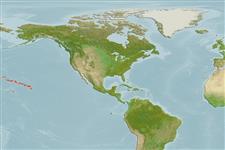Environment: milieu / climate zone / depth range / distribution range
Οικολογία
Θαλασσινό(ά) βενθοπελαγικό; εύρος βάθους 5 - 380 m (Ref. 5222). Tropical; 30°N - 11°N, 179°W - 153°W (Ref. 5222)
Eastern Central Pacific: known only from the Hawaiian Islands and Johnston Island.
Μέγεθος / Βάρος / Age
Maturity: Lm ? range ? - ? cm
Max length : 122 cm TL αρσενικό/απροσδιόριστο; (Ref. 4887); μεγ. δημοσιευμένο βάρος: 22.7 kg (Ref. 4887)
Ραχιαίες άκανθες (συνολικά) : 11; Μαλακές ραχιαίες ακτίνες (συνολικά) : 14 - 15; Εδρικές άκανθες: 3; Μαλακές εδρικές ακτίνες: 9. Distinguished by the following characteristics: juveniles greyish brown to dark brown body color with 8 vertical series of white spots on body; adults dark brown with less distinct vertical series of white spots and obscured by numerous additional pale spots and blotches of variable size; fins mostly unspotted; depth of body contained 2.3-2.7 times in SL, width 2.0-2.5 times in depth; head length 2.3-2.5 times in SL; convex interorbital area, width subequal to eye diameter for fish 10-20cm SL; subangular preopercle, 3-5 enlarged serrae at angle; fleshy ventral edge of preopercle, without serrae; smooth edge of interopercle and subopercle or with a few serrae; convex upper edge of operculum; ovate and enlarged posterior nostrils of adults, larger than anterior nostrils (Ref. 89707).
Occurs in deep waters (Ref. 7364). Benthic and benthopelagic (Ref. 58302). Feeds mainly on fish and crustaceans (Ref. 89707). A good fish to eat, fleshy, eaten any way except raw (Ref. 7364). Minimum depth from Ref. 122680.
Life cycle and mating behavior
Γεννητική Ωρίμανση | Αναπαραγωγή | Γεννοβολία | Αβγά | Γονιμότητα | Προνύμφες
Craig, M.T. and P.A. Hastings, 2007. A molecular phylogeny of the groupers of the subfamily Epinephelinae (Serranidae) with revised classification of the epinephelini. Ichthyol. Res. 54:1-17. (Ref. 83414)
IUCN Red List Status (Ref. 130435: Version 2024-1)
Threat to humans
Harmless
Human uses
αλιεία: Εμπορικό(ά); αλιεία αναψυχής: ναί; Ενυδρείο: Εμπορικό(ά)
Εργαλεία
Special reports
Download XML
Διαδικτυακές πηγές
Estimates based on models
Preferred temperature (Ref.
123201): 9.3 - 15.3, mean 15.1 °C (based on 3 cells).
Phylogenetic diversity index (Ref.
82804): PD
50 = 0.5001 [Uniqueness, from 0.5 = low to 2.0 = high].
Bayesian length-weight: a=0.01445 (0.00822 - 0.02541), b=3.05 (2.90 - 3.20), in cm total length, based on LWR estimates for this species & Genus-body shape (Ref.
93245).
Τροφικό Επίπεδο (Ref.
69278): 4.0 ±0.67 se; based on food items.
Ελαστικότητα (Ref.
120179): Χαμηλό, ελάχιστος χρόνος για διπλασιασμό πληθυσμού 4,5 - 14 έτη (Preliminary K or Fecundity.).
Fishing Vulnerability (Ref.
59153): High to very high vulnerability (70 of 100).
Nutrients (Ref.
124155): Calcium = 38.4 [18.1, 76.4] mg/100g; Iron = 0.587 [0.297, 1.119] mg/100g; Protein = 17.3 [15.5, 19.1] %; Omega3 = 0.234 [0.132, 0.418] g/100g; Selenium = 108 [53, 231] μg/100g; VitaminA = 22.3 [7.4, 74.3] μg/100g; Zinc = 0.837 [0.566, 1.273] mg/100g (wet weight);
